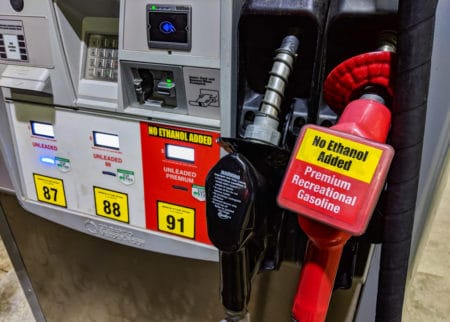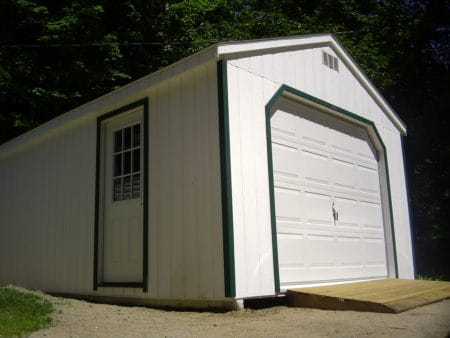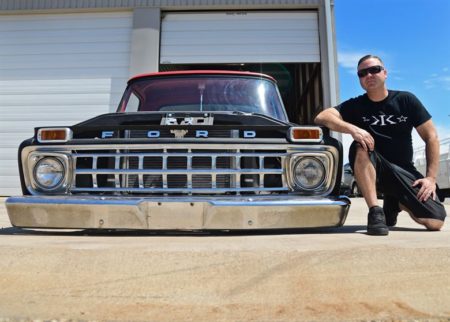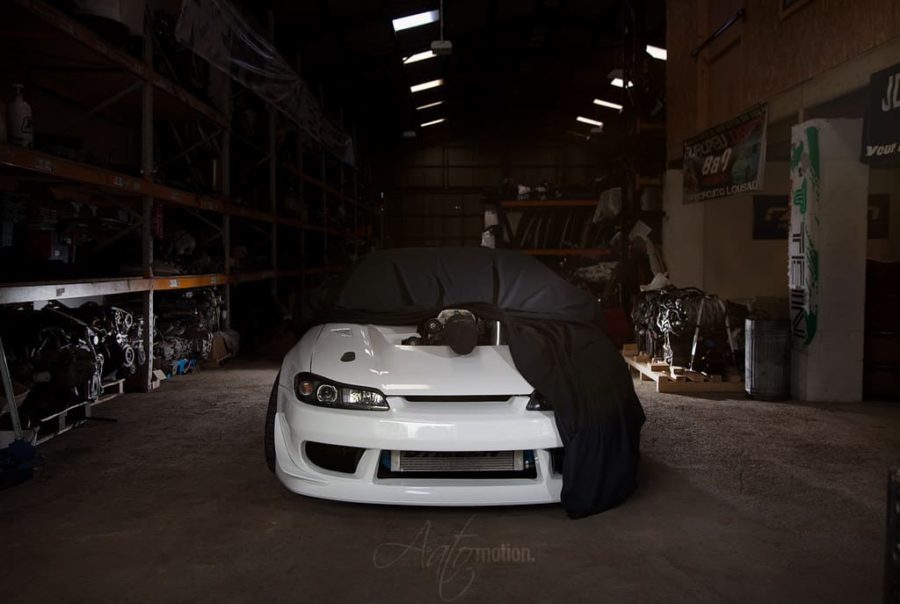Driving around in a lowered, powerful, RWD car can be a lot of fun… As long as it’s a nice day! If there’s any rain, good luck getting grip. If you’re looking to daily drive your drift car, or even use it on weekends, you’ll need a place to store it during the off-season. What happens if you don’t have a garage?
Keeping your drift car indoors during the winter is ideal. A garage is choice one, being in a contained area you can control. If you don’t have access to one, then next would be reaching out to friends and family, see if they have extra room. If not, then looking for public storage will be your answer.
Of course, like everything else that has drifting involved, it’s not that simple. There are nuances with each manner of storage, including damage risk, vandalism, and even the possibility of theft. Be sure where you’re leaving your drift car is safe!
Preparing Your Car For Storage
If your car is going to sit stagnant for an entire season, you’d bet there’s some work to do beforehand! There’s going to be four main points of focus: fuel, driveline, wheels/suspension, and electronics. If you leave any of these four alone, come springtime, you’re going to have a hell of a time getting your car driving again!
Fuel
 Fuel has an expiration date. Regardless if you’re using 110 octane race fuel, or straight unleaded pump gas, it’s still a volatile substance. Being volatile is why fuel burns so well, and also why it expires. It can’t stay on the verge of combustion forever, eventually the chemicals that make up your gasoline are going to split, and become inert. Have you ever tried to start an old carbureted engine with old fuel? Those inert chemicals can really gum up a carb, solidifying and plugging jets. That same solidified junk that would plug a carburetor is what would happen if you didn’t treat your fuel before storage! You don’t want your injectors getting gummed up, do you?
Fuel has an expiration date. Regardless if you’re using 110 octane race fuel, or straight unleaded pump gas, it’s still a volatile substance. Being volatile is why fuel burns so well, and also why it expires. It can’t stay on the verge of combustion forever, eventually the chemicals that make up your gasoline are going to split, and become inert. Have you ever tried to start an old carbureted engine with old fuel? Those inert chemicals can really gum up a carb, solidifying and plugging jets. That same solidified junk that would plug a carburetor is what would happen if you didn’t treat your fuel before storage! You don’t want your injectors getting gummed up, do you?
Treating fuel has become extremely simple, with the invention of STABIL. That’s a red fluid that comes in a little bottle, and you add a certain amount (based on how much fuel you have) into your gas tank. Then, just mix it up, and you’re safe! STABIL prevents the oxidation and solidification of your fuel, keeping your fuel fresh for up to 12 months. The best part is, when it comes time to take your car out of storage, you can start the engine right up! You don’t have to siphon any of that old gas, or the STABIL, out of your fuel. Just drive your car like you normally would, and the STABIL will get burned right alongside the gas. After a couple tanks of gas, all the traces of STABIL will be out of your car’s system, and you’ll be good as new.
Driveline
We have to make a few things happen here, to make sure your car will be able to roll around when you come back in the spring. Leaving your driveline with slack is important, as is leaving the car in neutral, disengaging your parking brake, and having your car elevated on blocks.
Leaving your driveline with tension on it over long periods of time runs the risk of deforming pieces, or having them rust together. A bent driveline can cause vibrations and other imbalances while driving, which is never good. It’s also very power inefficient, with some of your engine’s power going towards shaking the car. Make sure you park your car without anything binding (welded differentials especially!). To ensure your gearbox doesn’t bind, make sure the car is in neutral before you leave. This will disengage the shifter forks in the transmission, and hopefully avoid it getting stuck in whatever gear you parked it in!
To release the tension on the braking system, make sure you disengage your handbrake. This is for a similar reason to parking the car in neutral, we don’t want pieces getting stuck together. If you leave your handbrake on for six months, it runs the risk of rusting to the brake rotor, rendering it stuck! Instead of using the handbrake to hold the car, consider chocking the wheels to prevent rolling. That, or try my next step, which is to put the car up on blocks.
Wheels/Suspension
 While your wheels and suspension usually have to hold the weight of your car, that doesn’t mean that taking the weight off helps. Think about your own feet, standing on them for six months straight would be pretty uncomfortable, right? Give your car’s feet a break, but it up on blocks of wood! If you can bring a jack and some 6×6 lumber, you’re set! The length of your lumber depends entirely on your car. While you’re at home, jack up the rear end of your car until your tires are about three inches from the ground. Then, measure the distance between where you’d put your jack stands and the ground. That’s the length of your rear blocks! Just rinse and repeat for the front, and you’ll have the amount of lumber you need.
While your wheels and suspension usually have to hold the weight of your car, that doesn’t mean that taking the weight off helps. Think about your own feet, standing on them for six months straight would be pretty uncomfortable, right? Give your car’s feet a break, but it up on blocks of wood! If you can bring a jack and some 6×6 lumber, you’re set! The length of your lumber depends entirely on your car. While you’re at home, jack up the rear end of your car until your tires are about three inches from the ground. Then, measure the distance between where you’d put your jack stands and the ground. That’s the length of your rear blocks! Just rinse and repeat for the front, and you’ll have the amount of lumber you need.
For one, this helps with ensuring your car will actually be there when you get back (but I’ll talk more about that in the Safety section). The maintenance-related reason, however, is to reduce the wear on your suspension components, as well as prevent flat-spotting your tires. Taking the load off your suspension can help prevent embrittlement in your suspension, having sat in nearly the same place for so long. Keeping your tires nice and round is just a bonus! Sitting on one point of the tires for months on end tends to slightly deform the tires. However, if the car isn’t sitting on the tires at all, you won’t have an issue with that! Just use a jack to take your car off the blocks, and you’re good to drive away.
Electronics
This is rather simple, but vital information for anyone storing batteries or electronics. Don’t leave your battery in your car! Even if the building is heated, there’s always a risk something breaks, and then your $200 car battery is crumpets (like toast, but British!). On top of that, batteries are prone to leaking if left hooked up and unused. Simply disconnecting your battery would only solve one of those two issues. Removing it and taking it home with you, however, solves both issues! As a bonus, you’ll be able to test the battery to make sure it’s still good, and put a maintainer on it.
Where To Store Your Drift Car
Now that you know how to store your drift car, the next question is “where”. There’s plenty of different options, and no one “correct” option, albeit one that comes close. It really depends on your situation, but whichever you choose, you’ll know your car is safe from the elements!
Inside Your Own Garage

This is my personal choice, where I’d store the 240 if possible. Having sole access to your car, being able to work on it and check up on it, there’s nothing that can really beat that. I’d still recommend removing your battery and all the other winter storage tips above, but you won’t have to worry about locking your doors, or leaving your windows rolled up. As a matter of fact, it’s a fairly good idea to roll them down, in order to ventilate the car’s interior.
The only real downside of storing in your own garage is not having the room for other things, such as snowblowers or your winter driving car. If you have a two car garage or larger, this isn’t an issue, but for those of us in the one-car gang, we don’t have much room for anything else. You’ll have to get creative with where you store your snowblower, unless you shovel, in which case you’re good. You’ll also have to run into the freezing cold to get to your daily driver, since it can’t be in the garage. If you’re willing to put up with this, and have the room, this is the superior option.
Inside Someone Else’s Garage
 Having a friend or family member that you trust enough to store your drift car with is rare, don’t get me wrong. I’m protective of my car too! However, if you don’t have a place to store your car, and someone you trust has a garage spot open, or better yet, has access to a warehouse, then that’ll do. Leaving your prized car with someone else isn’t easy, but there’s precautions you can take in order to prevent damage.
Having a friend or family member that you trust enough to store your drift car with is rare, don’t get me wrong. I’m protective of my car too! However, if you don’t have a place to store your car, and someone you trust has a garage spot open, or better yet, has access to a warehouse, then that’ll do. Leaving your prized car with someone else isn’t easy, but there’s precautions you can take in order to prevent damage.
One of the oldest tricks in the book is cardboard. Having a few large pieces of this bad boy will allow you to prevent door dings on your car. With just a car cover, if someone opens their car door into yours, you’re sure gonna see it in spring. With that extra layer of protection, however, you can let the cardboard take the brunt of the impact, leaving your paint unharmed!
In the end, it comes down to how much you trust the person. Will they treat your car with just as much care as you treat it with? If that answer is a “no”, then maybe this isn’t your best choice. Ease of access gets trumped by the safety of your baby, every time!
In Public Winter Storage
 The idea of public storage isn’t my favorite either, but hear me out. Most fairgrounds have some sort of winter storage program, if they have spare barns or other buildings. The prices are fairly cheap, and the buildings are under lock and key. The problem here is if you aren’t the last person to put your car in that building, you won’t be the first to leave in the spring. That gives the other people storing their vehicles in there a chance to be around your car, and possibly damage it.
The idea of public storage isn’t my favorite either, but hear me out. Most fairgrounds have some sort of winter storage program, if they have spare barns or other buildings. The prices are fairly cheap, and the buildings are under lock and key. The problem here is if you aren’t the last person to put your car in that building, you won’t be the first to leave in the spring. That gives the other people storing their vehicles in there a chance to be around your car, and possibly damage it.
There’s two ways to solve this issue. One, show up the last day of storage, and wait until everybody else is stored before you put yours in. This may complicate things at the facility, but it’ll ensure you’re the last one in that day. The second option, the one I was forced to use, is to ask to go in a day late, for an up-charge. I didn’t exactly do this on purpose, I had driven out there to be at the end of the final day of the drop-off period. My wheel studs, however, had other plans! Lesson learned, make sure you have all your lug nuts on!
Regardless, I had to pay a small fee, but the people running the winter storage program let me come in a day late. That ensured my car would be at the very front of the unit, and thus, had to come out first. I was the last one in, and the first one out, everything worked out!
In A Storage Unit
 This storage method has the lowest risk of your car getting damaged. Behind lock and key, and in a gated storage facility, it doesn’t get much more safe than that. You also get fairly unrestricted access to your car, whether it be for repairs or for sentimental reasons. You’ll still have to remove your battery, since most storage units don’t have outlets for a battery tender. I’d certainly recommend leaving the windows cracked for ventilation, it can get quite musty in there. Leave some dryer sheets or mouse balls around your car as well, to avoid any unwanted passengers making a meal of your interior!
This storage method has the lowest risk of your car getting damaged. Behind lock and key, and in a gated storage facility, it doesn’t get much more safe than that. You also get fairly unrestricted access to your car, whether it be for repairs or for sentimental reasons. You’ll still have to remove your battery, since most storage units don’t have outlets for a battery tender. I’d certainly recommend leaving the windows cracked for ventilation, it can get quite musty in there. Leave some dryer sheets or mouse balls around your car as well, to avoid any unwanted passengers making a meal of your interior!
You may not have the room to lift your car onto blocks for the season, but a good alternative is to over-inflate your tires. While it does stretch them a little, it will help negate the effects of flat-spotting. If you can store the car before swapping your tires, this is all the better, as the stretched tires won’t be an issue.
What To Check Before Driving Away In Spring
Getting your drift car stored for the winter is fine and dandy, but what happens come spring? Is the engine gonna blow up when you turn it over? Will it overheat on the drive home? What about random rats popping out of the interior? As long as you prepare your car correctly when you put it in storage, you won’t have to worry about any of this! Now you’ll have to remove all the dryer sheets, but that’s about it! Bring a jack to take your car off the blocks, check to make sure your brakes aren’t locked up, and just head on out!
When you first pull out, check all your fluid levels, as well as the ground under where your car was. If there’s any leaks, use a tissue or paper towel to check the color of the fluid. This will help you determine what leaked from your car, and whether it’s crucial to your engine’s health. While you’re driving home, make sure there’s no odd noises, or weird shaking or sputtering. Having something plugging one of your injectors (or your carburetor) could be devastating to your engine, causing a misfire. Some seals may have shriveled during the winter, and once they warm up again for the season, they may assume a different shape, opening up leaks. Consistently monitor your gauges on your way home, in case you lose oil pressure or coolant.
Last, but certainly not least, is to top off your fuel with some fresh gas. During the initial drive, spend some time burning gas, in order to make room. Diluting the older gas with some fresh will help liven up the fuel, making this tank burn better.

